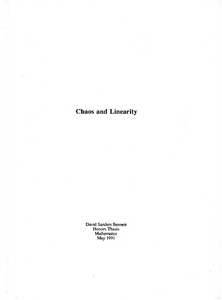| dc.description.abstract | Mathematically, one may define chaos in relation to the behavior of discrete dynamical systems, i.e., the behavior of operators (functions) under iteration. R. Devaney, in his book An Introduction to Chaotic Dynamical Systems [l], gives a rigorous definition for chaos in such systems. Devaney's definition, as we shall see, preserves the everyday notions of chaos. That is, a chaotic system by Devaney's definition is characterized by complex, turbulent behavior. In contrast, when the word linear describes mathematical structure, one almost certainly assumes that structure has a simple, orderly character. Indeed, the words simple and orderly describe the dynamics of a linear operator on a Euclidean space of finite dimension. Devaney himself describes such operators as having "extremely simple dynamics" [l, p. 190]. Moreover, in much of the literature describing chaos and chaotic operators, one often encounters the statement "nonlinearity gives rise to chaos." It would seem, then, that chaos and linearity are incompatible. Not so! In fact, linear operators on infinite dimensional spaces may be chaotic (although, as the reader will shortly see, linear operators on finite dimensional spaces must fail to be chaotic). . . . In the following paper, I will present an example of a chaotic linear operator on an infinite dimensional vector space. [From Introduction] | en_US |
| dc.rights | This material is made available for use in research, teaching, and private study, pursuant to U.S. Copyright law. The user assumes full responsibility for any use of the materials, including but not limited to, infringement of copyright and publication rights of reproduced materials. Any materials used should be fully credited with the source. | en_US |
